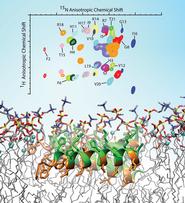
Associate Professor of Chemistry Myriam Cotten is the corresponding author of a paper that was published online on Jan. 10 in the Journal of the American Chemical Society (JACS). The results presented are the culmination of more than five years of work as part of Cotten’s National Science Foundation CAREER grant.
“High-Resolution Structures and Orientations of Antimicrobial Peptides Piscidin 1 and Piscidin 3 in Fluid Bilayers Reveal Tilting, Kinking, and Bilayer Immersion,” presents the first high-resolution structures of helical antimicrobial peptides bound to fluid lipid bilayers. William Wieczoreck, ’11, Alexander Dao, ’12, Robert Hayden, ’14, and Caitlyn Burzynski, ’12, are co-authors on the paper. Cotten’s collaborators include Dr. Richard Pastor, ’71, senior investigator in the Laboratory of Computational Biology at the National Heart, Lung and Blood Institute, which is part of the National Institutes of Health.
While antimicrobial peptides are characterized by low incidence of induced bacterial resistance, traditional antibiotics are losing their effectiveness due to inappropriate and excessive use that exacerbates this resistance.
The Center for Disease Control and Prevention states that “Each year in the United States, at least 2 million people become infected with bacteria that are resistant to antibiotics and at least 23,000 people die each year as a direct result of these infections. Many more people die from other conditions that were complicated by an antibiotic-resistant infection.” Therefore, there is a strong motivation to use antimicrobial peptides as templates to design new therapeutics. Piscidin 1 is known to be one of the most potent antimicrobial peptides, of which more than 2,300 are known.
Piscidin 1 and ascaphin-8 are the only two antimicrobial peptides reported to demonstrate activity against a broad spectrum of bacteria, HIV-1, and some cancer cells. One of the major goals of the research presented in the paper was to investigate molecular features of piscidins 1 and 3 that underlie their potency and explain the higher efficacy of piscidin 1. The piscidin structures were solved by solid-state Nuclear Magnetic Resonance (NMR) in the presence of bacterial cell mimics. Interpreting the NMR results on piscidin was challenging because measurements could be biased by the peptide motions taking place under the native-like conditions used to record the data.
The authors were able to demonstrate the validity of the NMR measurements by using computational molecular dynamics simulations, carried out on piscidin independently of the NMR work. An important conclusion reached by the authors is that in contrast to the ideal structures shown in models that describe the mechanisms of action of antimicrobial peptides, both piscidins adopt disrupted structures that allow them to interact very strongly with lipid bilayers as needed to initiate their disruptive effects. The investigations also provided molecular details that help better understand why piscidin 1 is more efficacious than piscidin 3.
According to the website, JACS is the flagship journal of the American Chemical Society. It is published weekly, and provides research essential to the field of chemistry.
Photo Caption: This study provides the structures of antimicrobial peptides piscidins 1 and 3 in two bacterial cell mimics. Refinements using restraints from solid-state NMR spectra yield structures and orientations in agreement with all-atom MD simulations that indicate ±15º fluctuations in peptide tilt, and locate the peptides below the C2 of the lipid acyl chains”
Posted January 22, 2014
